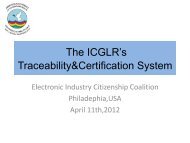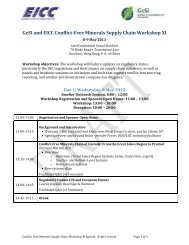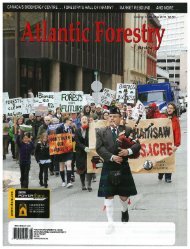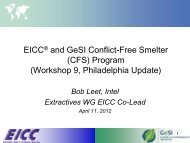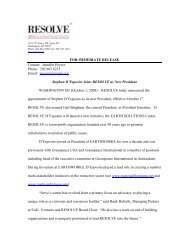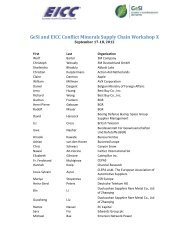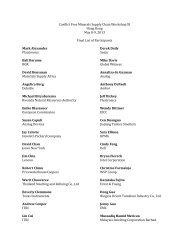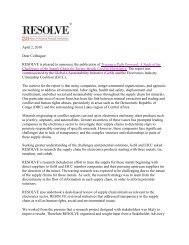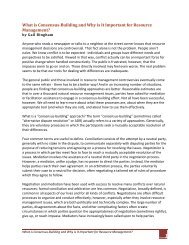Toward SuSTainabiliTy: The roleS and limiTaTionS of ... - Resolve
Toward SuSTainabiliTy: The roleS and limiTaTionS of ... - Resolve
Toward SuSTainabiliTy: The roleS and limiTaTionS of ... - Resolve
Create successful ePaper yourself
Turn your PDF publications into a flip-book with our unique Google optimized e-Paper software.
Chapter 2: Actors – NGOs <strong>and</strong> Civil Society 20be tackled solely through national-scale policies<strong>and</strong> regulatory systems. Tropical forests were stilldisappearing. And, the political environment hadshifted toward a preference for smaller government,freer trade, <strong>and</strong> resistance to regulation.Also, a rapid increase in economic globalizationmeant that pollution constraints could easilybe allayed by transferring production to foreigncountries.Two decades after Silent Spring, nongovernmentalorganizations (NGOs) such as Friends<strong>of</strong> the Earth, the Rainforest Action Network, <strong>and</strong>Greenpeace were running boycott campaignsagainst unsustainably harvested tropical timber<strong>and</strong> other environmentally harmful practices, whilean array <strong>of</strong> socially focused NGOs led boycotts <strong>of</strong>Nike over labor practices in Asia (Donovan, 1996;Locke, 2002). (<strong>The</strong>se actions followed successfulboycotts in the 1970s <strong>of</strong> table grapes because<strong>of</strong> farmworker issues, Shell Oil products due toinvestments in South Africa under apartheid, <strong>and</strong>Nestlé for its marketing <strong>of</strong> baby formula (Murtagh& Lukehart, undated)).While these groups gained political leverage <strong>and</strong>drew media attention, productive operating alternativeswere difficult to identify. In the forestryarena, legislative bans on the import <strong>of</strong> unsustainableforest products ran afoul <strong>of</strong> rules aboutunfair discrimination against tropical timber. Atthe international level, attempts to embed forestryst<strong>and</strong>ards in the International Tropical TimberOrganization (ITTO) <strong>and</strong> to pass a global ForestConvention through the United Nations bothfell short, due to global North–South conflicts<strong>and</strong> opposition from the tropical timber trade(Cashore, Gale, Meidinger, & Newsom, 2006).It was against this backdrop that some NGOsbegan to promote sustainability-focused certificationsystems as a new <strong>and</strong> sometimesless-confrontational form <strong>of</strong> environmental<strong>and</strong> social activism. As described in Chapter 1,a group <strong>of</strong> NGOs in the early 1990s, buildingon earlier efforts, coalesced to build the ForestStewardship Council (FSC) as a powerful form<strong>of</strong> nonstate market governance, regulating <strong>and</strong>managing resource use <strong>and</strong> trade (Cashore, Auld,& Newsom 2004). In most cases these effortsdid not supplant more confrontational efforts,but instead existed alongside them (McAdam,McCarthy, & Zald, 1996; Morton, 2002).Bartley (2007a et seq.) contends that the engagement<strong>of</strong> NGOs in certification, at least in theseminal case <strong>of</strong> the FSC, was shaped by a group <strong>of</strong>foundations acting collectively to build the field <strong>of</strong>certification. Bartley also notes that this approachto environmental problem solving coincided bothwith significant new barriers to the regulation<strong>of</strong> global commerce by national actors (e.g., theWorld Trade Organization (WTO) prohibitionon discrimination against tropical timber on thebasis <strong>of</strong> production issues, as well as rules <strong>of</strong> theITTO), <strong>and</strong> with a period <strong>of</strong> phenomenal growthin foundation assets.In the case <strong>of</strong> certification, the foundations thatmade the bulk <strong>of</strong> the investments 1 already hadin place a basic framework—the SustainableForest Funders Network—for collaboratingtoward a collective result. <strong>The</strong>se foundations alsoshared certain key characteristics, including aliberal to moderate ideology, a history <strong>of</strong> fundingenvironmental organizations, <strong>and</strong> importantly,existing relationships with the World Wide Fundfor Nature (WWF), which was a central player inthe development <strong>of</strong> the FSC <strong>and</strong> similar models(Bartley, 2007a). Foundations strongly favored theFSC over its industry-sponsored competitors, butrather than merely fund the FSC itself, they usedtheir grants to build a larger field around thisorganization <strong>and</strong> to “make a market” for certifiedwood. Although a similar network did not emergeto promote the Marine Stewardship Council(MSC), major funding from foundations suchas the David <strong>and</strong> Lucile Packard Foundation <strong>and</strong>Walton Family Foundation enabled the MSC togrow, <strong>and</strong> complementary programs supporting1 Nine foundations—<strong>The</strong> Ford Foundation, Doris DukeCharitable Foundation, Rockefeller Brothers Fund,Surdna Foundation, Pew Charitable Trusts, MacArthurFoundation, Moriah Foundation, Wallace Global Fund,<strong>and</strong> Merck Family Fund—accounted for $33 milliongranted to forestry certification from 1995 to 2001(Bartley 2007a).<strong>Toward</strong> Sustainability: <strong>The</strong> Roles <strong>and</strong> Limitations <strong>of</strong> Certification



